Abstract
The further identification of fault types for single line-to-ground faults (SLGFs) in distribution networks is conducive to determining the cause of grounding faults and formulating targeted measures for hidden danger treatment and fault prevention. For the six types of SLGFs generated in the actual power grid, this paper deeply studies their fault characteristics. Firstly, the classification criterion of fault transition resistance is derived by the generation mechanism of fault zero sequence voltage (ZSV). At the same time, by comparing and analyzing the same and different characteristics between faults, three criteria for fault classification are obtained. Based on the above four criteria, a multilevel and multicriteria fault classification method is proposed to judge six types of SLGFs. Then, the proposed method is verified by various fault state simulations of the distribution network model with a balanced topology and unbalanced topology. The engineering application of the method is demonstrated by the verification of actual power grid data. Finally, noise and data loss interference test results show the robustness of the method.
1. Introduction
The probability of SLGFs in distribution network systems reaches 80% [1,2]. Due to the variety of fault types and working conditions, it is easy to fail in distinguishing fault types and performing troubleshooting in time, resulting in the expansion of the fault range. Therefore, it is a worthwhile task to further analyze the characteristics of multiple faults, as well as identifying and classifying the faults for the formulation of fault response measures in distribution networks.
There are various fault identification methods for distribution networks, mainly including fault feature analysis and data-driven artificial intelligence methods. On this basis, scholars have carried out extensive research on fault classification in distribution networks, including fault feeder detection, fault phase classification, and fault type classification.
Fault feeder detection and location: Most SLGF identification studies classify feeders into two categories, fault and health types, commonly referred to as SLGF feeder detection. Some studies use waveform analysis methods. In [3], the authors extracted the negative sequence component characteristics of a three-phase current and voltage through a wavelet transform (WT). Ref. [4] extracted the features by principal component analysis and obtained feeder discrimination results through the binary classification of the features using support vector machines. In [5], the zero sequence current (ZSC) matrix constructed by the Hilbert transform was decomposed by singular values to obtain an amplitude polarity eigenmatrix. There are also some studies using entropy [6], singular spectrum decomposition [7], feature mode decomposition [8], and so on. With the widespread application of artificial intelligence technology in power systems, some studies have used intelligent algorithms such as sparse encoders [9,10], machine learning [11,12,13], artificial neural networks [14,15,16], convolutional neural networks [17,18,19], and neural networks [20] for fault detection and location.
Fault phase classification: Research on multiple fault classification mainly focuses on the classification of grounding phases, aiming to distinguish whether a single line-to-ground fault, an interphase short-circuit fault, or a three-phase short-circuit fault has occurred. Ref. [21] used the depth map learning algorithm for fault location and classification. In [14], after extracting features with the Hilbert–Huang transform, a convolutional neural network (CNN) achieved the classification of the extracted features. Ref. [22] extracted the DC component via a mathematical morphology to realize the fault classification of power distribution cables.
Fault type classification: Recently, some researchers have emphasized the classification of fault types. Refs. [2,23,24] are classification studies aimed at identifying high-impedance faults. Refs. [25,26], respectively, applied the negative selection algorithm and CEEMDAN algorithm to distinguish the transition resistance degree in SLGFs. Ref. [27] describes a more comprehensive classification study of fault causes, using a dual-channel CNN intelligent algorithm. Ref. [28] focuses on two transient processes and detects intermittent grounding faults.
However, there are some problems in existing fault classification methods.
- (1)
- Insufficient fault types: In the research of SLGF detection in a distribution network, there are few studies on fault type classification, and the types of faults are also limited. However, multiple types of faults occur in the actual operation of distribution networks, such as transition resistance grounding faults, arc grounding faults, intermittent grounding faults, and transient grounding faults. It is necessary to consider different types of faults, so as to formulate prevention and handling measures for specific faults.
- (2)
- Classification method: The diversity of fault conditions and categories, as well as the limited applicability of a single identification method, can lead to misjudgment for different faults. Although artificial intelligence methods are often used to solve classification problems, they rely on the data size of the databases [29], especially for multi-fault classification research, posing challenges to the completeness of the database.
- (3)
- Fault data: In actual distribution networks, most of the collected single line-to-ground fault data are recorded as SLGFs. These faults are not recognized as transition resistance grounding faults (TRGFs), arc grounding faults (AGFs), intermittent grounding faults (IGFs), transient grounding faults (TGFs), etc. Moreover, some faults, such as TGFs, may not require protection actions. Thus, it is difficult to obtain realistic recorded data containing multiple types of SLGFs.
The main contributions of this paper are as follows.
- (1)
- Multi-type fault classification: We utilize six types of SLGFs in the actual distribution network to identify and classify the specific type of grounding fault, which is conducive to further determining the causes of grounding faults in the distribution network and formulating targeted measures for hidden danger management and fault elimination.
- (2)
- Multilevel method: We construct a decision-tree-based multilevel strategy for fault type classification. By grouping the same features and distinguishing different features, four criteria are obtained based on the feature analysis of different fault types. Moreover, a multilevel progressive classification method for the SLGFs is carried out.
- (3)
- Realistic recorded waveforms: The data verified in this paper are the actual single line-to-ground fault (SLGF) data in China’s distribution network, which include six types: small-impedance faults (SIFs), medium-impedance faults (MIFs), high-impedance faults (HIFs), arc grounding faults (AGFs), intermittent grounding faults (IGFs), and transient grounding faults (TGFs). The verification of the actual fault data reflects the engineering applicability of the method.
2. Fault Transition Conductance Analysis
Figure 1 shows an equivalent operational circuit based on ZSV, where , , and are the potentials of a three-phase power supply, is the neutral grounding admittance, is the ZSC flowing through the neutral branch, and and are the phase A to ground capacitance and conductivity of the feeder lk.
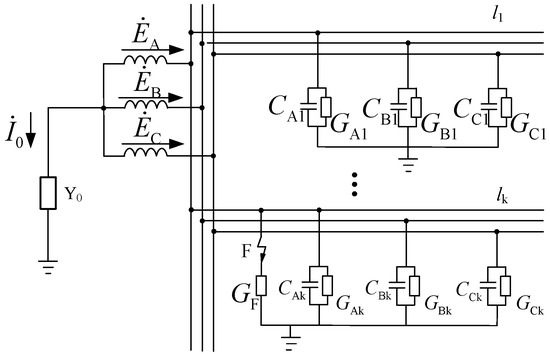
Figure 1.
Equivalent operational circuit.
When a grounding fault has not yet occurred, the unbalanced current of feeder k is defined as :
Thus, the sum of the unbalanced currents of all feeders is
As shown in Figure 2, in order to offset the unbalanced current of each feeder, needs to be generated while ensuring that both parts of the neutral point comply with the Kirchhoff law. Adding the voltage to the zero sequence impedance, the generated current is equal to the sum of all unbalanced currents, and Formula (3) is derived.
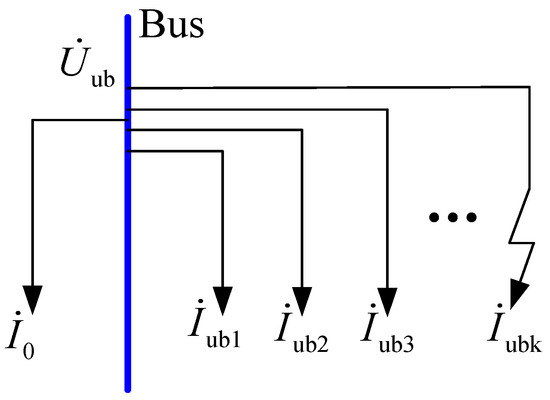
Figure 2.
Unbalanced current of feeders.
When a single line-to-ground fault occurs in phase A, point F in Figure 1 is connected. is the transitional conductivity. The phase A to ground admittance becomes , while the phase B and phase C to ground admittance remains unchanged. Thus, the total zero sequence admittance of the power grid is
The sum of the unbalanced currents during faults is
According to the ZSV generation principle in Figure 2, it can be obtained that
By organizing Formulas (2) and (5), we obtain the unbalanced current relationship of pre- and post-fault.
Using Formulas (3) and (6), it can be calculated from Formula (7) that
Among them, is the voltage of the faulty phase, and can be further deduced.
is the grounding fault current, indicating the current difference in the pre- and post-fault generated by the ZSV on the zero sequence admittance. From Formula (9), it can be concluded that the fault transition conductance is directly proportional to the variation of ZSV and inversely proportional to the fault phase voltage, which becomes the basis for Criterion 4 in Section 3.4.
3. Multilevel Classification Method
The fault recorder data of the Xinjiang region in 2021 are shown in Figure 3a, where the ZSC waveforms include the following six SLGFs: a small-impedance fault (SIF), medium-impedance fault (MIF), high-impedance fault (HIF), arc grounding fault (AGF), intermittent grounding fault (IGF), and transient grounding fault (TGF).

Figure 3.
ZSC waveforms of 6 types of faults.
The diverse types of faults make it difficult to obtain a single criterion based on the characteristics of the zero sequence current waveforms. The FFT was used to transform the waveforms to the frequency domain, as shown in Figure 3b, and it can be seen that the frequency with the largest amplitude is still the fundamental frequency. Other high-frequency harmonics have extremely low amplitudes and a relatively small proportion, and they are relatively disorderly and irregular.
It can be seen that the criterion constructed by a single feature is insufficient to support the differentiation of multiple types of faults. To distinguish these 6 types of faults, progressive classification needs to be carried out based on their different features.
3.1. Criterion 1
Variational mode decomposition (VMD) differs in principle from empirical mode decomposition (EMD) and its improved algorithms, effectively avoiding modal aliasing. VMD decomposes sampled signal X(t) into several intrinsic mode functions (IMFs) with central frequencies [30]. The actual transient signal frequency of grounding faults in distribution networks is approximately 300 to 1000 Hz. Based on the decomposition test of actual fault-recorder waveforms, we found that it is appropriate to divide the waveforms into three modes.
As shown in Figure 4, the original fault waveform is divided into three modes, and transforming them into the corresponding frequency domain indicates that each mode has actual physical significance: IMF1 corresponds to 50 Hz, representing the fundamental frequency component; IMF2 corresponds to 750 Hz, representing the high-frequency component; and IMF3 corresponds to high-frequency noise signals above 2000 Hz.
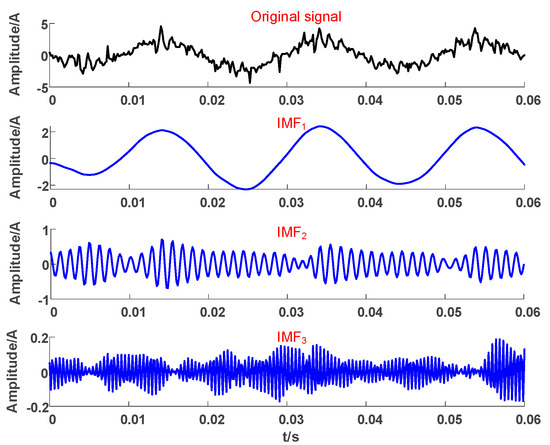
Figure 4.
Decomposition results of ZSC.
When the grounding fault occurs, the transient high-frequency component changes obviously. As shown in Figure 5a, there are two transient processes in the IGF waveform. Observing the envelope of its high-frequency component IMF2, we found that there are two peaks in different periods, which can be used to identify IGFs. The high-frequency component of the transition resistance grounding fault (TRGF) in Figure 5b shows a decreasing oscillation trend, with no second peak appearing.
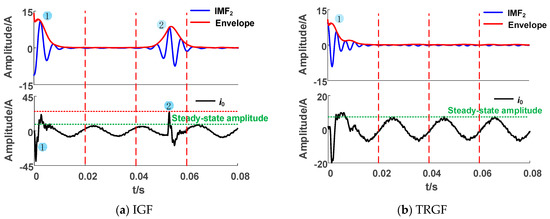
Figure 5.
High frequency component envelope lines of actual system faults.
Criterion 1: Calculating the number of peaks in each period of the characteristic IMFs after fault occurred, we obtained the peak distribution matrix S = [s1 s2 s3 … sT]. If Formula (10) is satisfied, it indicates that there is not only one transient process in the high-frequency component, corresponding to the characteristics of the IGF (Label Ⅰ) and AGF (Label Ⅰ), and the fault with Label Ⅱ has only one transient process.
Due to the reignition of the AGF leading to multiple transient processes, Criterion 2 is constructed to distinguish between an IGF and AGF.
3.2. Criterion 2
For an AGF, in addition to the first transient process of the fault, there are also multiple arcing and arc-extinguishing states, so the complexity of the waveform is greater than that of the IGF. Permutation entropy can measure the complexity of time series [31]. It introduces permutation when calculating the complexity between reconstructed subsequences. There is a time series X(t) = {x(1), x(2), x(3),…, x(n)} of length n. We specify an embedding dimension m and a time delay , and then reconstruct the original sequence as
In the above formula, , each row L(t) of Y is a reconstruction component, and each reconstruction component is reordered in ascending order:
We obtained the permutation order of each reconstructed component:
The probability of each permutation order is , and the permutation entropy formula is defined as
is the occurrence number of the same order, and is the type of permutation order, which has at most m! permutations, so .
Based on the above analysis, we propose detection Criterion 2. Calculate the permutation entropy pe of ZSC for each feeder. If , the fault is judged as an AGF; otherwise, we determine that an IGF has occurred. After a large number of experiments under different fault conditions, we set the for the radial distribution network and the actual system (where the recorder data are obtained from) as 0.9, and the for the unbalanced distribution network as 0.8.
3.3. Criterion 3
During the recovery process after the SLGF disappears, the ZSV shows a trend of oscillation and attenuation. In order to calculate this attenuation trend, we define the attenuation degree of ZSV in the T-th period after the fault as
where and are the ZSV amplitudes of the T-th and (T + 1)-th periods after the fault. Generally, when the ZSV continues to decay to 5% of the amplitude at the time of the fault, the system is considered to be restored.
Criterion 3 is constructed. When the amplitude of the ZSV continues to decay for N periods (starting from the T-th period), the attenuation set is . If meets and the ZSV meets , it indicates that a TGF has occurred; otherwise, the fault is judged as a TRGF.
3.4. Criterion 4
In the fault analysis in Section 2, we obtained ∝ as well as ∝. On this basis, is introduced to facilitate the classification of the grounding transition resistance.
where is the variation of ZSV, and the transition resistance is negatively correlated with , so it is also positively correlated with the variation of ZSV. With and as the boundary, there are three situations:
We obtain Criterion 4. If ≤ , the fault is determined as an HIF. If < ≤ , the fault is determined as an MIF. Otherwise, > , and we judge the fault as an SIF. After extensive experiments under different fault conditions, we set the radial distribution network with = 0.1 and = 1, the unbalanced distribution network with = 0.005 and = 0.05, and the actual system (where the recorder data are obtained from) with = 1 and = 5.
3.5. Multi-Type Fault Classification Method
We propose a multilevel fault nature classification process as shown in Figure 6. The classification process covers 4 criteria. According to the flow chart of multi-category fault identification, the classification steps are listed as follows.
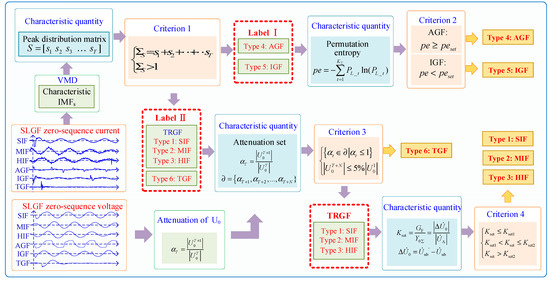
Figure 6.
Multilevel fault nature classification process.
Steps: (1) The ZSC and ZSV of each fault feeder are taken as the object of feature analysis. The ZSC of all faults is decomposed by VMD, and we extract the frequency characteristics under different spectra and relate them to the time domain.
(2) After calculating the peaks of the feature IMFs, Criterion 1 categorizes AGFs and IGFs with multiple transient processes into a large category.
(3) By using Criterion 2 to calculate the ZSC permutation entropy pe, AGFs and IGFs can be distinguished.
(4) After determining attenuation set and calculating the amplitude of ZSV in the last period, the TGF can be distinguished by Criterion 3.
(5) Criterion 4 divides TRGFs into SIFs, MIFs, and HIFs according to the transition resistance.
4. Simulation and Test Verification
As shown in Figure 7, we established a 10 kV radial distribution network model in the electromagnetic transient simulation software. It consists of four feeders, among which feeder l1 and l2 are overhead lines, feeder l3 includes a cable and overhead line, and feeder l4 is a cable. The parameters of the overhead line and cable are shown in Table 1 [32].
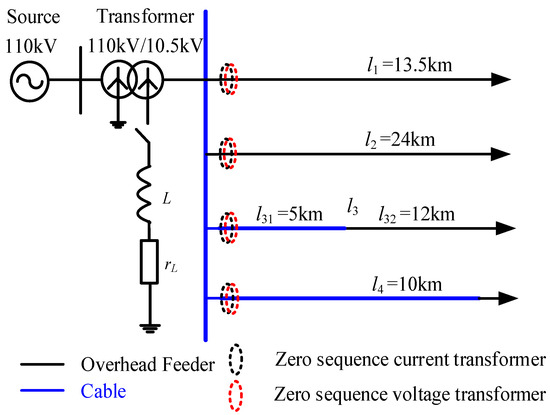
Figure 7.
Radial distribution network model.

Table 1.
Feeder parameters.
4.1. Different Fault Condition Test
To verify the universality of the proposed method, different fault conditions were simulated. In Table 2, the different fault feeders, fault transition resistance, and fault types are listed.

Table 2.
Fault setting parameters.
We collected the ZSC and ZSV of faults under different conditions and identified faults by the classification process proposed in Section 2. Firstly, we calculated the number in the peak matrix. As shown in Figure 8, when AGFs and IGFs occur, the number of peaks within the statistical period is greater than 1. However, the transient processes of TGF, SIF, MIF, and HIF faults only occur in the initial stage of the fault, so there is only one peak. The results of Criterion 1 are shown in Table 3, and the faults are preliminarily divided into two labels: Label I and Label II.

Figure 8.
High frequency component envelope lines for radial network faults.

Table 3.
Criterion 1 judgment results for radial network faults.
Secondly, Criterion 2 is used to calculate the permutation entropy value of each fault feeder in Label I. The permutation entropy pe reflects the complexity of the ZSC waveform. In Table 4, we can see that the pe values of AGFs are larger than (value is 0.9), while the pe values of IGFs are lower. Thus, Type 4 (AGF) and Type 5 (IGF) are distinguished.

Table 4.
Criterion 2 judgment results for radial network faults.
Then, we selected the fault that met Criterion 3 from Label II. Figure 9 shows the change trend of the ZSV during the occurrence of a TGF. It can be seen that when the fault is over, the ZSV continues to decrease. As shown for the TGF in Table 5, the attenuation degree of the first four periods is less than 1, and the ZSV value in the fifth period is less than 5% of the initial value. In the TRGF, except for an HIF, the of all other faults are greater than 1 within the statistical periods, indicating that the waveform has not decayed. However, when the HIF voltage no longer decays, the ZSV value is too large to meet , so it is judged as a TRGF (SIF, MIF, and HIF).
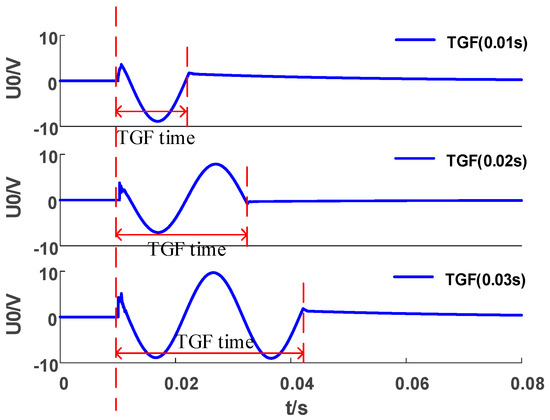
Figure 9.
ZSV of TGF fault.

Table 5.
Criterion 3 judgment results for radial network faults.
Finally, based on the variation of ZSV and the voltage of the fault phase, we calculated the value of , which is positively correlated with the transition conductance; then, we compared it with the criterion parameters (value is 0.1) and (value is 1) in Criterion 4. The results are shown in Table 6. The SIF meets > , the MIF meets < ≤ , and the HIF meets ≤ . It can be seen that the order of magnitude of decreases with the increase in transition resistance.

Table 6.
Criterion 4 judgment results for radial network faults.
4.2. Unbalanced Load Test
As shown in Figure 10, we established an IEEE-13 node model. Its nominal voltage is 4.16 kV, and it is characterized by short lines, high loads, substation voltage regulators, overhead feeders and underground cables, parallel capacitors, line transformers, and unbalanced loads.

Figure 10.
IEEE-13 node distribution network model.
Six types of SLGFs were simulated at nodes 633 and 692, and the ZSC and ZSV were recorded by sensors installed at the heads of the lines. The judgment results are shown in Table 7.

Table 7.
Criterion 1 judgment results for unbalanced load network faults.
As shown in Table 7 and Table 8, the peak matrix was calculated and determined by Criterion 1, where the sum of the peaks in Label I is higher than 1. Then, the permutation entropy of ZSC in Label I (AGF and IGF) was calculated by Criterion 2. Since the AGF waveform is complex, the pe value of the AGF is much larger than that of the IGF.

Table 8.
Criterion 2 judgment results for unbalanced load network faults.
Table 9 and Table 10 show the classification results of faults included in Label II (SIF, MIF, and HIF). By analyzing the trend of ZSV attenuation degree , we can check whether the ZSV value at the end of attenuation is less than the 5% of the initial fault value. The fault that meets Criterion 3 is a TGF; otherwise, it is a TRGF. The value of the TRGF is compared by Criterion 4, which ranges from high to low in SIFs, MIFs, and HIFs.

Table 9.
Criterion 3 judgment results for unbalanced load network faults.

Table 10.
Criterion 4 judgment results for unbalanced load network faults.
5. Practical Fault Data Verification
The SLGF data are recorder waveforms of the Xinjiang distribution network in China, covering six fault types, SIF, MIF, HIF, AGF, IGF, and TGF, as shown in Figure 11.

Figure 11.
Recorded waveforms of actual SLGFs.
As shown in Figure 11a, when an SIF occurs, the zero sequence current waveform suddenly changes and then returns to a stable state. The comparison of SIFs, MIFs, and HIFs shows that the current amplitude decreases with the increase in transition resistance. The AGF current waveform has obvious extinction–reignition–extinction characteristics and gradually increases to its maximum value. There is an obvious transient process in the initial stage of the IGF current, and it then gradually stabilizes. However, the waveform oscillates again and a second transient process appears. The ZSC waveform oscillates significantly during the TGF occurrence; the ZSC approaches zero after fault recovery.
In the ZSV waveforms shown in Figure 11b, the SIF, MIF, and HIF waveforms are similar to sine waves, and only their amplitudes are different. The AGF waveform has significant distortion, with a saddle-shaped appearance. The IGF voltage also has a second transient process like the current. The ZSV continues to decay to approximately 0 after the TGF disappears.
Table 11 shows the judgment results of the six types of fault waveforms. As can be seen, based on Criterion 1 and Criterion 2, it is possible to preliminarily determine Type 4 (AGF) and Type 5 (IGF); other waveforms that do not belong to these two Types will be classified as Type 6 (TGF) and TRGFs (SIFs, MIFs, and HIFs) based on Criterion 3. Finally, the TRGF is classified as Type 1 (SIF), Type 2 (MIF), and Type 3 (HIF) by Criterion 4. All types of faults are judged correctly.

Table 11.
Judgment results of actual data.
6. Adaptability Analysis
6.1. Noise Test
In practical applications, due to the presence of various disturbances, the quality of the received signal will decrease [33,34,35,36]. In order to simulate the noise that often occurs in practical engineering applications, Gaussian white noise is usually superimposed on the original ZSC signal. As shown in Figure 12, after adding Gaussian white noise, the waveform is distorted. With the decrease in the signal-to-noise ratio (SNR), the distortion degree of the zero sequence current waveform superimposed with 20 dB noise (compared to SNR = 30 dB) is higher.
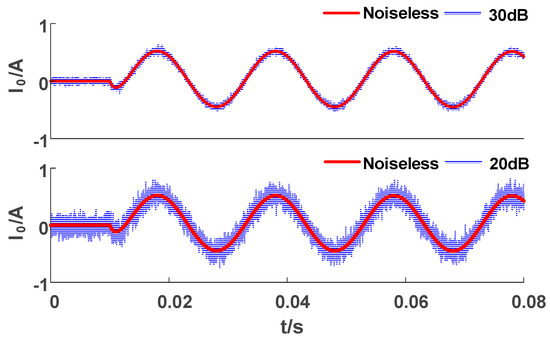
Figure 12.
ZSC superimposed with Gaussian white noise.
Table 12 shows the classification results of ZSC waveforms with superimposed 20 dB noise. The AGF and IGF are firstly distinguished by the sum of the peaks and the size of the permutation entropy. Then, as the ZSV of the TGF continuously decays for two cycles and the third cycle returns to a normal voltage value, it is distinguished from a TRGF. Finally, the SIF, MIF, and HIF are distinguished due to their different magnitudes.

Table 12.
Judgment results under 20 dB noise.
6.2. Data Loss Test
During the actual operation of the power system, communication may be disturbed, resulting in data loss during transmission. To simulate the above situation, we randomly remove some data and fill in zeros, as shown in Figure 13.

Figure 13.
ZSC with random loss.
Unlike the impact of the superimposed noise conditions, data loss affects the complexity and amplitude of the waveform. As shown in Table 13, the value of pe in Criterion 2 slightly increases, and the value in Criterion 3 also changes, but the classification result remains unchanged.

Table 13.
Judgment results under 5% data loss.
7. Conclusions
Aiming at the classification of multiple types of single line-to-ground faults in actual systems, four criteria are proposed by analyzing the same and different features of six types of faults. The proposed method has been validated in radial distribution networks, unbalanced distribution networks, and the realistic recorded data of faulty sensors in an actual system. This is conducive to determining the cause of grounding faults and formulating targeted measures for hidden danger treatment. We obtained the following conclusions.
- (1)
- By deducing the generation mechanism of the zero sequence voltage, we obtained the relationship between the transition conductance, the in ZSV, and the fault phase voltage: the transition conductance is positively correlated with the variation in ZSV and inversely correlated with the fault phase voltage.
- (2)
- After we analyzed and compared the characteristics of various SLGFs, we obtained inductive criteria for the same features and discrimination criteria for different features. Using four criteria to construct a multi-level classification method, the waveforms under different fault conditions were verified, and the results showed that the proposed method has high reliability.
- (3)
- The proposed method judged faults correctly for both balanced and unbalanced topology models. Moreover, the method has good robustness under interference conditions, such as noise effects and data loss. In addition, the validation of actual fault data indicates that the method has certain engineering applicability.
It is necessary to acknowledge the limitations of this work. Some criteria need to accumulate enough data to set the threshold for each different network, which will take a certain time in the actual system. Therefore, in our future work, we intend to deeply investigate the characteristics of the fault itself and reduce the reliance on the data quantity.
Author Contributions
Conceptualization, J.L.; Methodology, J.L. and C.L.; Software, Y.L. and J.S.; Validation, C.L. and Y.L.; Formal analysis, J.S.; Investigation, H.L.; Data curation, Y.L.; Writing—original draft, C.L.; Writing—review and editing, J.S. and H.L.; Visualization, H.L.; Supervision, J.L. All authors have read and agreed to the published version of the manuscript.
Funding
This research was funded by the National Natural Science Foundation of China (52177114) and State Grid Xinjiang Electric Power Co., Ltd. (D230DK210023).
Institutional Review Board Statement
Not applicable.
Informed Consent Statement
Not applicable.
Data Availability Statement
The data presented in this study are available on request from the corresponding author. The data are not publicly available due to the need to use some of the data in this paper in subsequent research.
Conflicts of Interest
The authors declare no conflict of interest.
Abbreviations
| SLGF | Single line-to-ground fault |
| ZSV | Zero sequence voltage |
| WT | Wavelet transform |
| ZSC | Zero sequence current |
| VMD | Variational mode decomposition |
| EMD | Empirical mode decomposition |
| CEEMDAN | Complete ensemble empirical mode decomposition with adaptive noise |
| IMF | Intrinsic mode function |
| CNN | Convolutional neural network |
| TRGF | Transition resistance grounding fault |
| SIF | Small-impedance fault |
| MIF | Medium-impedance fault |
| HIF | High-impedance fault |
| AGF | Arc grounding fault |
| IGF | Intermittent grounding fault |
| TGF | Transient grounding fault |
References
- Liu, K.; Zhang, S.; Li, B.; Zhang, C.; Liu, B.; Jin, H.; Zhao, J. Faulty Feeder Identification Based on Data Analysis and Similarity Comparison for Flexible Grounding System in Electric Distribution Networks. Sensors 2021, 21, 154. [Google Scholar] [CrossRef] [PubMed]
- Hou, Z.Q.; Zhang, Z.H.; Wang, Y.Z.; Duan, J.D.; Yan, W.Y.; Lu, W.C. A Single-Phase High-Impedance Ground Faulty Feeder Detection Method for Small Resistance to Ground Systems Based on Current-Voltage Phase Difference. Sensors 2022, 22, 4646. [Google Scholar] [CrossRef] [PubMed]
- Jiang, J.A.; Chuang, C.L.; Wang, Y.C.; Hung, C.H.; Wang, J.Y.; Lee, C.H.; Hsiao, Y.T. A Hybrid Framework for Fault Detection, Classification, and Location-Part I: Concept, Structure, and Methodology. IEEE Trans. Power Deliv. 2011, 26, 1988–1998. [Google Scholar] [CrossRef]
- Ghaderi, A.; Mohammadpour, H.A.; Ginn, H.L.; Shin, Y.J. High-Impedance Fault Detection in the Distribution Network Using the Time-Frequency-Based Algorithm. IEEE Trans. Power Deliv. 2015, 30, 1260–1268. [Google Scholar] [CrossRef]
- Guo, M.-F.; Yang, N.-C. Features-clustering-based earth fault detection using singular-value decomposition and fuzzy c-means in resonant grounding distribution systems. Int. J. Electr. Power Energy Syst. 2017, 93, 97–108. [Google Scholar] [CrossRef]
- Wu, S.-D.; Wu, P.-H.; Wu, C.-W.; Ding, J.-J.; Wang, C.-C. Bearing Fault Diagnosis Based on Multiscale Permutation Entropy and Support Vector Machine. Entropy 2012, 14, 1343–1356. [Google Scholar] [CrossRef]
- Yan, X.A.; Liu, Y.; Xu, Y.D.; Jia, M.P. Multichannel fault diagnosis of wind turbine driving system using multivariate singular spectrum decomposition and improved Kolmogorov complexity. Renew. Energy 2021, 170, 724–748. [Google Scholar] [CrossRef]
- Yan, X.; Jia, M. Bearing fault diagnosis via a parameter-optimized feature mode decomposition. Measurement 2022, 203, 112016. [Google Scholar] [CrossRef]
- Chen, K.; Hu, J.; He, J. Detection and Classification of Transmission Line Faults Based on Unsupervised Feature Learning and Convolutional Sparse Autoencoder. IEEE Trans. Smart Grid 2018, 9, 1748–1758. [Google Scholar] [CrossRef]
- Chen, K.; Hu, J.; He, J. A Framework for Automatically Extracting Overvoltage Features Based on Sparse Autoencoder. IEEE Trans. Smart Grid 2018, 9, 594–604. [Google Scholar] [CrossRef]
- Deng, X.; Yuan, R.; Xiao, Z.; Li, T.; Wang, K.L.L. Fault location in loop distribution network using SVM technology. Int. J. Electr. Power Energy Syst. 2015, 65, 254–261. [Google Scholar] [CrossRef]
- Yi, Z.; Etemadi, A.H. Line-to-Line Fault Detection for Photovoltaic Arrays Based on Multiresolution Signal Decomposition and Two-Stage Support Vector Machine. IEEE Trans. Ind. Electron. 2017, 64, 8546–8556. [Google Scholar] [CrossRef]
- Yu, K.; Zou, H.; Zeng, X.; Li, Y.; Li, H.; Zhuo, C.; Wang, Z. Faulty feeder detection of single phase-earth fault based on fuzzy measure fusion criterion for distribution networks. Int. J. Electr. Power Energy Syst. 2021, 125, 106459. [Google Scholar] [CrossRef]
- Jawad, R.S.; Abid, H. HVDC Fault Detection and Classification with Artificial Neural Network Based on ACO-DWT Method. Energies 2023, 16, 1064. [Google Scholar] [CrossRef]
- Pourahmadi-Nakhli, M.; Safavi, A.A. Path Characteristic Frequency-Based Fault Locating in Radial Distribution Systems Using Wavelets and Neural Networks. IEEE Trans. Power Deliv. 2011, 26, 772–781. [Google Scholar] [CrossRef]
- Jamali, S.; Bahmanyar, A.; Ranjbar, S. Hybrid classifier for fault location in active distribution networks. Prot. Control. Mod. Power Syst. 2020, 5, 17. [Google Scholar] [CrossRef]
- Guo, M.-F.; Yang, N.-C.; Chen, W.-F. Deep-Learning-Based Fault Classification Using Hilbert-Huang Transform and Convolutional Neural Network in Power Distribution Systems. IEEE Sens. J. 2019, 19, 6905–6913. [Google Scholar] [CrossRef]
- Du, Y.; Liu, Y.; Shao, Q.; Luo, L.; Dai, J.; Sheng, G.; Jiang, X. Single Line-to-Ground Faulted Line Detection of Distribution Systems With Resonant Grounding Based on Feature Fusion Framework. IEEE Trans. Power Deliv. 2019, 34, 1766–1775. [Google Scholar] [CrossRef]
- Yang, D.; Pang, Y.; Zhou, B.; Li, K. Fault Diagnosis for Energy Internet Using Correlation Processing-Based Convolutional Neural Networks. IEEE Trans. Syst. Man Cybern.-Syst. 2019, 49, 1739–1748. [Google Scholar] [CrossRef]
- Marin-Quintero, J.; Orozco-Henao, C.; Bretas, A.S.; Velez, J.C.; Herrada, A.; Barranco-Carlos, A.; Percybrooks, W.S. Adaptive Fault Detection Based on Neural Networks and Multiple Sampling Points for Distribution Networks and Microgrids. J. Mod. Power Syst. Clean Energy 2022, 10, 1648–1657. [Google Scholar] [CrossRef]
- Hu, J.; Hu, W.; Chen, J.; Cao, D.; Zhang, Z.; Liu, Z.; Chen, Z.; Blaabjerg, F. Fault Location and Classification for Distribution Systems Based on Deep Graph Learning Methods. J. Mod. Power Syst. Clean Energy 2023, 11, 35–51. [Google Scholar] [CrossRef]
- Zhu, K.; Pong, P.W.T. Fault Classification of Power Distribution Cables by Detecting Decaying DC Components With Magnetic Sensing. IEEE Trans. Instrum. Meas. 2020, 69, 2016–2027. [Google Scholar] [CrossRef]
- Xiao, Q.-M.; Guo, M.-F.; Chen, D.-Y. High-Impedance Fault Detection Method Based on One-Dimensional Variational Prototyping-Encoder for Distribution Networks. IEEE Syst. J. 2022, 16, 966–976. [Google Scholar] [CrossRef]
- Wang, X.; Gao, J.; Wei, X.; Song, G.; Wu, L.; Liu, J.; Zeng, Z.; Kheshti, M. High Impedance Fault Detection Method Based on Variational Mode Decomposition and Teager-Kaiser Energy Operators for Distribution Network. IEEE Trans. Smart Grid 2019, 10, 6041–6054. [Google Scholar] [CrossRef]
- Song, X.; Gao, F.; Chen, Z.; Liu, W. A Negative Selection Algorithm-Based Identification Framework for Distribution Network Faults With High Resistance. IEEE Access 2019, 7, 109363–109374. [Google Scholar] [CrossRef]
- Wang, X.; Song, G.; Gao, J.; Wei, X.; Wei, Y.; Kheshti, M.; Hu, Z.; Zhang, Z. High impedance fault detection method based on improved complete ensemble empirical mode decomposition for DC distribution network. Int. J. Electr. Power Energy Syst. 2019, 107, 538–556. [Google Scholar] [CrossRef]
- Liu, H.; Liu, S.; Zhao, J.; Bi, T.; Yu, X. Dual-Channel Convolutional Network-Based Fault Cause Identification for Active Distribution System Using Realistic Waveform Measurements. IEEE Trans. Smart Grid 2022, 13, 4899–4908. [Google Scholar] [CrossRef]
- Zhang, S.; Zang, T.; Zhang, W.; Xiao, X. Fault Feeder Identification in Non-effectively Grounded Distribution Network with Secondary Earth Fault. J. Mod. Power Syst. Clean Energy 2021, 9, 1137–1148. [Google Scholar] [CrossRef]
- Yuan, J.; Hu, Y.; Liang, Y.; Jiao, Z. Faulty Feeder Detection for Single Line-to-Ground Fault in Distribution Networks With DGs Based on Correlation Analysis and Harmonics Energy. IEEE Trans. Power Deliv. 2023, 38, 1020–1029. [Google Scholar] [CrossRef]
- Achlerkar, P.D.; Samantaray, S.R.; Manikandan, M.S. Variational Mode Decomposition and Decision Tree Based Detection and Classification of Power Quality Disturbances in Grid-Connected Distributed Generation System. IEEE Trans. Smart Grid 2018, 9, 3122–3132. [Google Scholar] [CrossRef]
- Fabila-Carrasco, J.S.; Tan, C.; Escudero, J. Permutation Entropy for Graph Signals. IEEE Trans. Signal Inf. Process. Netw. 2022, 8, 288–300. [Google Scholar] [CrossRef]
- Wei, X.; Wang, X.; Gao, J.; Yang, D.; Wei, K.; Guo, L.; Wei, Y. Faulty Feeder Identification Method Considering Inverter Transformer Effects in Converter Dominated Distribution Network. IEEE Trans. Smart Grid 2023, 14, 939–953. [Google Scholar] [CrossRef]
- Long, Y.; Zhao, F.; Zheng, M.; Jin, G.; Zhang, H.; Wang, R. A Novel Azimuth Ambiguity Suppression Method for Spaceborne Dual-Channel SAR-GMTI. IEEE Geosci. Remote Sens. Lett. 2021, 18, 87–91. [Google Scholar] [CrossRef]
- Kang, M.-S.; Baek, J.-M. Efficient SAR Imaging Integrated With Autofocus via Compressive Sensing. IEEE Geosci. Remote Sens. Lett. 2022, 19, 4514905. [Google Scholar] [CrossRef]
- Long, Y.; Zhao, F.; Zheng, M.; Jin, G.; Zhang, H. An Azimuth Ambiguity Suppression Method Based on Local Azimuth Ambiguity-to-Signal Ratio Estimation. IEEE Geosci. Remote Sens. Lett. 2020, 17, 2075–2079. [Google Scholar] [CrossRef]
- Kang, M.S.; Baek, J.M. SAR Image Reconstruction via Incremental Imaging With Compressive Sensing. IEEE Trans. Aerosp. Electron. Syst. 2023, 59, 4450–4463. [Google Scholar] [CrossRef]
Disclaimer/Publisher’s Note: The statements, opinions and data contained in all publications are solely those of the individual author(s) and contributor(s) and not of MDPI and/or the editor(s). MDPI and/or the editor(s) disclaim responsibility for any injury to people or property resulting from any ideas, methods, instructions or products referred to in the content. |
© 2023 by the authors. Licensee MDPI, Basel, Switzerland. This article is an open access article distributed under the terms and conditions of the Creative Commons Attribution (CC BY) license (https://creativecommons.org/licenses/by/4.0/).